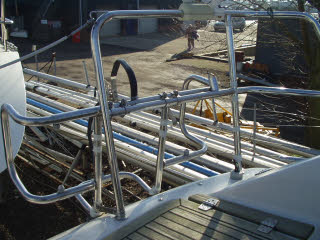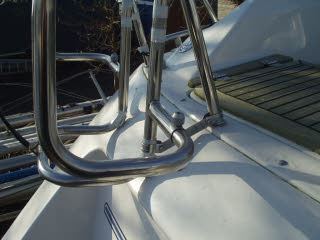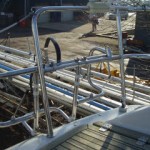chris
A Maxi 1000 problem I had last year was when the loo stopped working – I blamed others for blocking it, but found eventually that the holding tank was full of limescale – like the pipes get but this time blocking the internal stainless pipes and 8 – 10 mm thick on the side wall of the tank. I took out the tank and chipped and banged away to get it all out – a job worth doing this winter BEFORE IT BLOCKS if boat is 10 years old+
Also there has been a problem with the new PAR Brydon loos – they deleted a spring behind the inlet valve and many paople are having flushing water priming problems. If they are (as we are), they need to get the spring – this will fix it. They will supply it free!
Derek Gardner Oct 2006
Rob Ware, Eye of Horus adds… “We also had a blocked loo this summer and like Derek I initially blamed the crew. It turned out that limescale (up to 8 mm thick) in the hose between the loo and the holding tank had become dislodged and totally blocked the pipe. I ended up replacing the pipe. It is probably worth checking the internal condition of the pipe every couple of years.”
Chris Wildey adds… “I used RydLyme Marine earlier this year when I was getting worried about pipe blockage. It seems to have worked, and there is certainly no limescale in the tank itself after 5 years. It would be interesting to know how others have got on with this or other solutions. www.rydlymemarine.co.uk
 Richard provided these photos in response to a request from Bob Garrett.
Richard provided these photos in response to a request from Bob Garrett.
“Bob, I’ve fitted a liferaft to Thor, hanging it off the pulpit. I’m really pleased with it as I mounted it in a way that distributes the load down the pushpit rather than hanging off as many do. The pictures say it all – if not, shout and I’ll take some more. The bracket on the inboard side is a sort of meccano-looking dinghy chain-plate I got from the chandler. I used a piece of rubber hose taped to the tubing to rest on the transom. I’m sure you can work out the rest. The good thing is that you can rest the liferaft on the cradle without the retaining strap and the flagpole still fits.”
Richard Davidson, Thor
In my 38, the fuel tank is situated beneath the side galley. Looking aft from the galley sea cock hatch, the forward end of the fuel tank can be seen, at the base of which a drain plug. Ideally when the tank contents are low, but can be done with care when full, this plug can be removed and replaced by a tap available from your local plumbing merchant. Continue reading
At least a litre of water in the diesel tank containing 150 litres. This was initially discovered by inspection of the glass primary filter and no reason was forth coming until it was found that the “O” ring of the deck filler cap had disintegrated and broken. This turned out to be a very major task to remove this water and the question being had the igniters become rusted? Now where was the lowest point in the diesel tank and how to vacuum out both diesel and water via an inspection cover which would not lift more than 5 mm (yes, all 10 screws had been removed with difficulty). Not to prolong this agonising tale: check the “O” ring and if you do have to replace it (and carry a spare!) ensure it is made of “NITRILE” rubber otherwise it will disintegrate slowly with the diesel.
And on Diesel Bugs……
In the diesel where-o-where does it come from, especially when one hopes one is buying from a busy and reputable supplier. My particular BUG was dealt with using “Soltron” but there are others. Hopefully all’s well before the season starts?
Hugh Rowan
After sometimes struggling stowing my fully battened main, I wished I had specified in mast reefing, the following made life much easier:
Fit small round PVC discs at the leech end of the sail, directly opposite the mast shackle where the sail folds. When the sail is lowered, all you have to do is align the discs over the centre of the boom, knowing that this will fold the sail neatly and quickly.
The discs were fitted by a local sail maker during winter storage for just a few pounds, and while he was about it I asked him to replace those horrible plastic shackles with reinforced webbing sewn to the slides. This all makes for a much easier and neater stowed sail.
Barry Powling, Khamsin {Brittany France}
